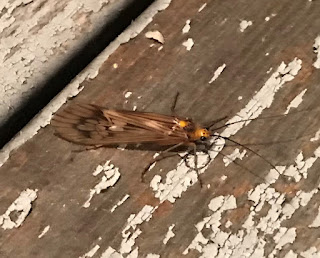Dec. 1st – NJ wild trout stream: Our youngest grandson needed someone to pick him up after school in New Jersey this afternoon, so I volunteered. I did this partly to help family, and partly to attempt to catch a December trout. I had lots of options, for larger fish, both wild browns and rainbows, but I chose to wander a special place instead, in pursuit of little wild brook trout. This is revered soil, steep in American history, paid for dearly by men committed to the ideals of a young nation. Plus I thought I might be able to seduce a few trout on dry flies, maybe for the last time until next spring.
I wandered some trails and found my way down into a hollow. The brook was clear, cold, and very low; somehow I don’t think the Garden State received as much rain as the eastern Catskills did in late October. Fish dimpled as I setup; a few tiny midges buzzed above the brook. Still I attached a #18 Adams, one of my favorite flies for situations like this. Without much effort, I successfully put all these fish down without nicking any. Thus I slowly worked my way up the tiny flow.
Soon I came upon a favorite spot, one that has always produced for me no matter the conditions, one where I think a spring seeps into the brook. Fish dimpled; I nicked two here, then caught my first little wild brook trout, all five inches of a mighty fish.
Continuing on I moved several more fish. Wherever one dimpled, it took my Adams though I fell short of hooking them all. And in likely looking spots, if I twitched the Adams--- a la Leonard Wright, often a fish would appear out of nowhere to grab it. I probably moved about two dozen fish to the dry fly, catching 9 brook trout.
Then around 12:30 conditions changed. For one thing, an overhanging branch stole my only #18 Adams on a sloppy backcast. So I attached a #18 Dorato Hares Ear, but it wasn’t the same, no fault of the pattern I’m sure. Shade creeped throughout the hollow, and masked the brook. Air temperatures dropped, bugs disappeared, and trout stopped rising. This little flow was shutting down for the day.
I spooked a couple more trout in sunlit tailouts, even a fish that probably pushed 8” to 9” long. But I only caught two more brook trout before quitting at 1:15 PM.
Thus today I wandered and fished this hollow for 2¼ hours, catching 11 wild brook trout 4” to 6” long all on dry flies, but only two fish during the last forty-five minutes.
If one has never fished this time of year, or during winter, I feel that angler has truly missed something unique. For one I know when summer fishing at Frost Valley, some days catching trout by the dozens, I often take moments like those for granted and don’t value each individual trout as much as I should. This time of year I believe the angling window of opportunity is very narrow, often one needing to be on the water when fish are active for a limited time. When a trout stream comes alive, when bugs move and fish feed, when a trout--- no matter its size--- puts a bend in one’s rod, and then just like that, everything shuts off for the day, maybe several days, those are magically moments to be appreciated and not diminished.
As Rene Harrop wrote in Trout Hunter, “Treat each trout as an individual and with respect. A wild trout is a worthy opponent; therefore, study it carefully and take nothing for granted.”
Growing up in the Garden State I never knew this environment existed, a sad commentary on my part. For now I’m probably done fishing for December, unless I get a bad case of the piscatorial itch, or we get a very warm day and I try a Catskill stream still open in hopes of finding a few rising trout. But for now, December is in the books.
So that’s it.
Ed




































